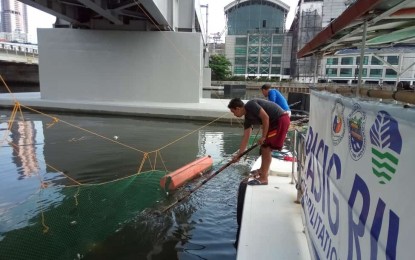
RIVER CLEANUP. Trash traps are installed in several strategic locations such as along Parola riverbank (bamboo traps), as well as under the McArthur Bridge, Quezon Bridge, and Paco-Sta.Mesa Bridge in Manila. The Pasig River cleanup is part of the ongoing rehabilitation of Manila Bay. (Photo courtesy of PRRC)
MANILA -- The Pasig River Rehabilitation Commission (PRRC) on Tuesday corrected what it called a misleading article posted by online news site Rappler on June 2 regarding the use of funds for the rehabilitation of waterways in Metro Manila.
PRRC Executive Director Jose Antonio E. Goitia said the article was erroneous, deceptive and offensive as it may lead the reading public to think that about PHP107.57 million was spent in 2018 for the rehabilitation and development of six waterways located in the cities of Manila and San Juan and now left uncompleted by the commission.
“The truth of the matter was that as of December 2018, only PHP29.63 million was spent for the rehabilitation of the San Juan River and five other esteros in Manila, as these are still ongoing,” Goitia said at the “Tapatan sa Aristrocat” press conference in Manila.
He said the commission has been strict in monitoring the progress of its rehabilitation projects, and that the delay was caused by factors beyond the control of PRRC.
“As early as 2016, PRRC already resettled informal settler families and dismantled illegal structures occupying the legal easements of Estero de Magdalena to pave way for the construction of a linear park development project. As soon as we finished the relocation and easement recovery, the linear park project was put up for bidding and awarded according to procurement laws. However, during the last quarter of 2017, the barangay officials in the area allowed families who were left homeless by a fire incident in Manila to occupy the already recovered easements of Estero de Magdalena,” Goitia said.
The families, he said, have been demanding for relocation houses from PRRC for them to leave Estero de Magdalena, and PRRC is already coordinating with other agencies, such as the National Housing Authority, to address the problem.
Goitia said the PRRC also encountered problems with erring barangay officials threatening its field engineers, as well as the project contractors to stop its project at Estero dela Reina and Estero de Pandacan.
Last year, the PRRC was recognized by the International RiverPrize Foundation as the Inaugural Asia RiverPrize for high level of response to the massive scale of problems faced by the Pasig River despite its limited resources and mandate, making it possible for the return of life -- fishes, birds, trees and other aquatic plants -- to the once biologically-dead river.
“We have no intention of slowing down as there is so much work to be done to keep the Pasig River System clean and alive. More importantly, I will never let government funds be wasted on incomplete projects,” he said.
To date, PRRC built 41.15 km. of linear parks, resettled almost 19,000 informal settler families, dismantled 508 privately owned structures at no cost to the government, dredged 3 million cubic meters of contaminated silts and sediments, and removed 30 million kg. of solid waste from the Pasig River and its tributaries. (PR)
